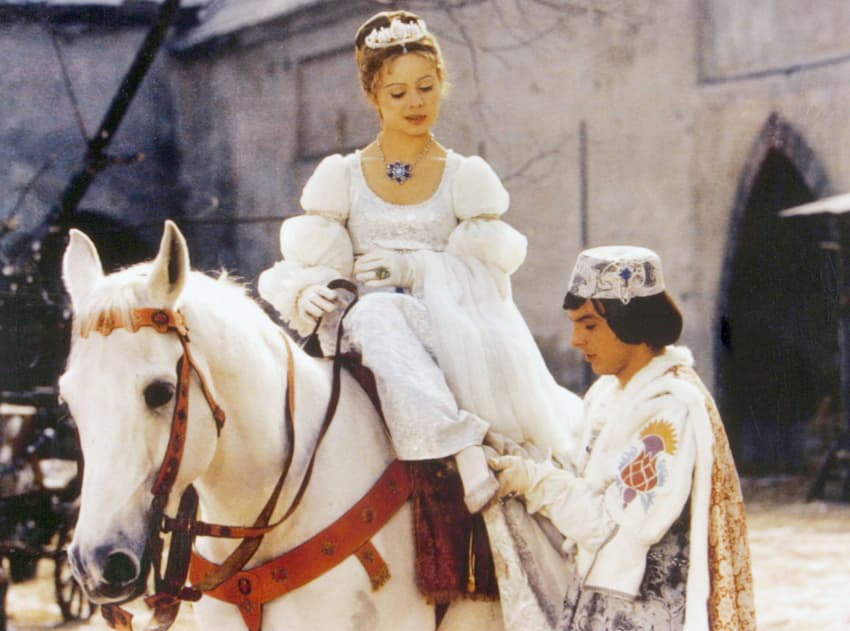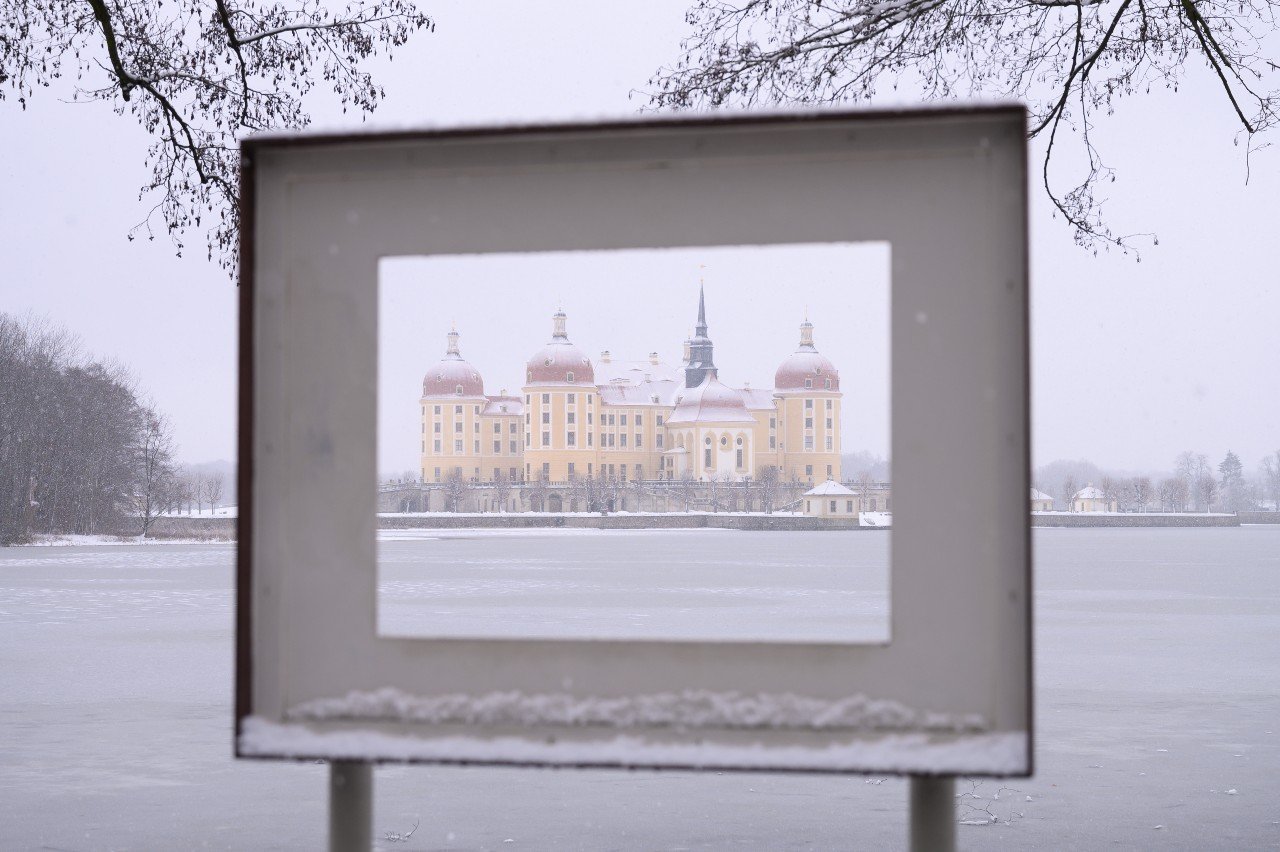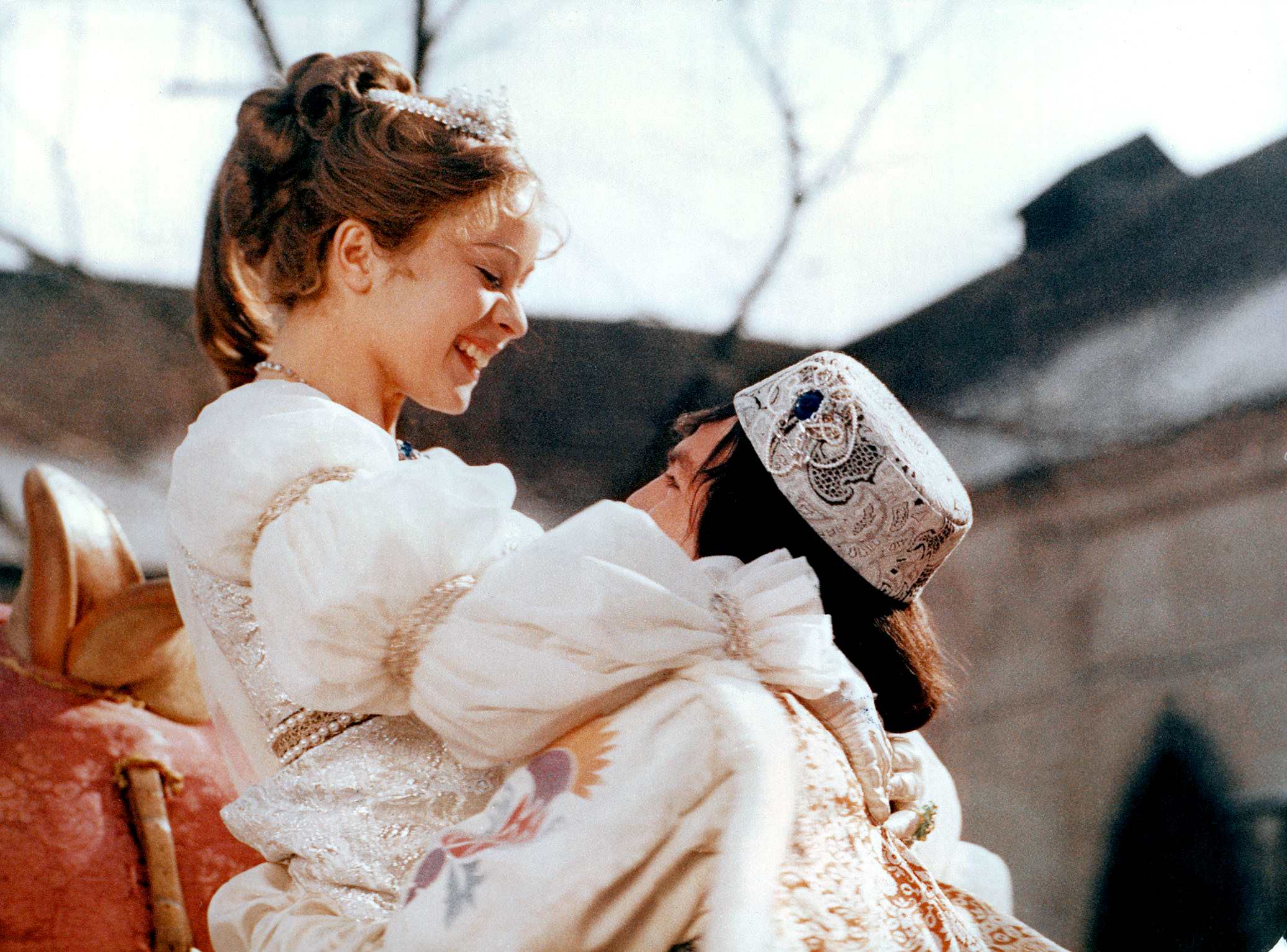‘Three Wishes for Cinderella’: How a 50-year-old German film became a Christmas classic

During the festive season, Germans of all ages go wild for a 50-year-old film that retells the story of Cinderella in a unique way. As a new exhibition opens, we explore how a children's film produced in the GDR become such a cultural phenomenon.
For many viewers in Germany, it's a film that is just as integral to Christmas as the trees and Lebkuchen. With its snowy landscapes and fairytale castles, the adaptation of ‘Three Wishes for Cinderella’ - or Drei Hasselnüsse für Ashenbrödel in German - has been enchanting audiences since its release in 1973.
In Germany, most people know the story of Cinderella (played by Czech actress Libuse Safrankova), who with courage and deception, cleverly wins over the heart of the handsome, but somewhat naïve, prince (Pavel Travnicek).
The onscreen fairytale turns 50 in November but its popularity shows no signs of wavering - both in Germany and elsewhere in Europe.
In fact, an exhibition based on the cult classic will soon be on display at Moritzburg Castle - a gothic castle in Saxony that was one of the shooting locations for the film.
It begins on Wednesday November 22nd and will include original costumes, memorabilia, props and more. Fans can also visit other filming locations from the outdoor shooting at the gothic Svihov Castle in the west of the Czech Republic and the snowy slopes of the Bohemian Forest on the German-Czech border.
Why does the film remain so popular?
Over the years, Three Wishes for Cinderella has become the classic Christmas film in Germany, as well as in the Czech Republic and Norway. Diana Heuschkel, editor of Desired magazine, summed up this German obsession when she wrote in a recent article: "Christmas is only half as nice without this film."
In a testament to its popularity, Three Wishes for Cinderalla was shown a whopping 15 times between December 1st and New Year last year on German and Norwegian TV.
In many ways, you could think of it as the Christmas version of "Dinner for One" - the British sketch that has become a New Year's Eve institution in German households.
READ ALSO: 50 years of a New Year's dinner for one
In the case of Cinderella, audiences love its romantic cinematography and festive wintry scenery, but it also stands out as a uniquely inter-cultural creation.

Saxony's Schloss Moritzburg in Saxony, where part of Three Wishes for Cinderella was filmed. Photo: picture alliance/dpa/dpa-Zentralbild | Sebastian Kahnert
With a cast of both German and Czech actors, the film was shot in multiple languages, with these characters then dubbed in each country to match the primary language.
Surprisingly though, this festive film was never intended to be a Christmas classic. In fact, the original plan was to shoot it in summer.
The first version of the script planned to have Cinderella running across the ‘blooming meadows’ and washing her laundry in a ‘sun-drenched creak’. It was a fortunate coincidence that the East-German film studio DEFA, the German co-production partner of the Barrandov Studio in Prague, had the means to produce the film in the winter of 1972/73.
DEFA also brought German acting legends to the table, including Rolf Hoppe who plays the king.
The script was quickly adapted to this change of season in just a few days.
'Autonomy and energy'
While November 1st, 1973 is traditionally cited as the official premiere date for today’s Christmas classic, investigations conducted by the National Film Archives in Prague revealed that the film began airing in Czechoslovakian cinemas on November 16th 1973. Interestingly, a gala premier for the socialist youth federation, SYU, had already taken place on October 26th.
READ ALSO: 10 must-see films and series to help you improve your German
Despite this early screening, the GDR-premiere was confirmed to have taken place on March 8th 1974. Unfortunately, some of the stars aren't around to see the anniversary celebrations; the main actress, Libuse Safrankova, sadly passed away in June 2021 at the age of 68.
One of the most memorable scenes of the film is the first meeting between Cinderella and the prince. When the heir to the throne is trying to hunt down a deer with his crossbow, he is suddenly struck by a snowball. It was thrown by the defiant Cinderella, who quickly runs away.

The prince (Pavel Travnicek) embraces Cinderella (Libuse Safrankova) - a scene from the classic "Three Wishes for Cinderella". Photo: picture alliance/dpa/WDR/DRA/ARD | -
”This is not the kind of girl who waits passively to be rescued by a prince,” says Michael Bregant - the head of the National Film Archives in Prague - in an interview with DPA.
“In this version, Cinderella acts with more autonomy and energy – that's what makes the film so interesting.”
Behind the scenes however, the young girl wasn’t the culprit behind the snowball attack: it was director Vaclav Vorlicek who threw the snowball with perfect precision from his spot next to the camera.
“Vorlicek was a director who had the ambition of producing successful and popular films," says Bregant about the filmmaker, who passed away in 2019. “He was no great philosopher, rather a pragmatist.”
Vorlicek’s sense of humour is also unmistakable. In an interview, he once said: "I walk through life with a smile, even when I am faced with obstacles, because deep down I am an optimist in nature."
READ ALSO: Why 'made in Germany' TV has captured the imagination of the world
Political turbulence
These obstacles were prominent back in 1973 when filming coincided with a time of political oppression and intensified censorship in Czechoslovakia. In August 1968, the Warsaw Pact states had crushed the Prague Spring reform movement with tanks.
Many artists fell from grace. "The incredible playwright and screenwriter Frantisek Pavlicek wrote the script hidden behind a pseudonym," explains the film expert Pavel Skopal – even though the fairytale has no political subtext.
Pavlicek completely contorted the traditional role of a scriptwriter and skilfully weaved in three fairy tale stories by the Czech national writer Bozena Nemcova (1820-1862). That’s why Cinderella opens some magic nuts herself instead of shouting for the "little tree, little tree, shake [its branches and release the nuts] over me" like in the Brothers Grimm edition.
The DEFA co-producers were worried that German children wouldn’t be able to recognise the fairytale, but this has obviously turned out to be untrue over time.
Pavel Travnicek, the actor who played the prince, was recently asked in an interview on Czech radio what first comes to his mind when he thinks back to the filming. “The winter... the winter, it was horrifically cold,” the 72-year-old immediately spurted out. The cast was young and endured temperatures of minus 17 degrees.
When he is shown photos from the time, he is almost moved to tears: “Damn, what a time.”
With reporting by Tom Ashton-Davies
Comments
See Also
For many viewers in Germany, it's a film that is just as integral to Christmas as the trees and Lebkuchen. With its snowy landscapes and fairytale castles, the adaptation of ‘Three Wishes for Cinderella’ - or Drei Hasselnüsse für Ashenbrödel in German - has been enchanting audiences since its release in 1973.
In Germany, most people know the story of Cinderella (played by Czech actress Libuse Safrankova), who with courage and deception, cleverly wins over the heart of the handsome, but somewhat naïve, prince (Pavel Travnicek).
The onscreen fairytale turns 50 in November but its popularity shows no signs of wavering - both in Germany and elsewhere in Europe.
In fact, an exhibition based on the cult classic will soon be on display at Moritzburg Castle - a gothic castle in Saxony that was one of the shooting locations for the film.
It begins on Wednesday November 22nd and will include original costumes, memorabilia, props and more. Fans can also visit other filming locations from the outdoor shooting at the gothic Svihov Castle in the west of the Czech Republic and the snowy slopes of the Bohemian Forest on the German-Czech border.
Why does the film remain so popular?
Over the years, Three Wishes for Cinderella has become the classic Christmas film in Germany, as well as in the Czech Republic and Norway. Diana Heuschkel, editor of Desired magazine, summed up this German obsession when she wrote in a recent article: "Christmas is only half as nice without this film."
In a testament to its popularity, Three Wishes for Cinderalla was shown a whopping 15 times between December 1st and New Year last year on German and Norwegian TV.
In many ways, you could think of it as the Christmas version of "Dinner for One" - the British sketch that has become a New Year's Eve institution in German households.
READ ALSO: 50 years of a New Year's dinner for one
In the case of Cinderella, audiences love its romantic cinematography and festive wintry scenery, but it also stands out as a uniquely inter-cultural creation.

With a cast of both German and Czech actors, the film was shot in multiple languages, with these characters then dubbed in each country to match the primary language.
Surprisingly though, this festive film was never intended to be a Christmas classic. In fact, the original plan was to shoot it in summer.
The first version of the script planned to have Cinderella running across the ‘blooming meadows’ and washing her laundry in a ‘sun-drenched creak’. It was a fortunate coincidence that the East-German film studio DEFA, the German co-production partner of the Barrandov Studio in Prague, had the means to produce the film in the winter of 1972/73.
DEFA also brought German acting legends to the table, including Rolf Hoppe who plays the king.
The script was quickly adapted to this change of season in just a few days.
'Autonomy and energy'
While November 1st, 1973 is traditionally cited as the official premiere date for today’s Christmas classic, investigations conducted by the National Film Archives in Prague revealed that the film began airing in Czechoslovakian cinemas on November 16th 1973. Interestingly, a gala premier for the socialist youth federation, SYU, had already taken place on October 26th.
READ ALSO: 10 must-see films and series to help you improve your German
Despite this early screening, the GDR-premiere was confirmed to have taken place on March 8th 1974. Unfortunately, some of the stars aren't around to see the anniversary celebrations; the main actress, Libuse Safrankova, sadly passed away in June 2021 at the age of 68.
One of the most memorable scenes of the film is the first meeting between Cinderella and the prince. When the heir to the throne is trying to hunt down a deer with his crossbow, he is suddenly struck by a snowball. It was thrown by the defiant Cinderella, who quickly runs away.

”This is not the kind of girl who waits passively to be rescued by a prince,” says Michael Bregant - the head of the National Film Archives in Prague - in an interview with DPA.
“In this version, Cinderella acts with more autonomy and energy – that's what makes the film so interesting.”
Behind the scenes however, the young girl wasn’t the culprit behind the snowball attack: it was director Vaclav Vorlicek who threw the snowball with perfect precision from his spot next to the camera.
“Vorlicek was a director who had the ambition of producing successful and popular films," says Bregant about the filmmaker, who passed away in 2019. “He was no great philosopher, rather a pragmatist.”
Vorlicek’s sense of humour is also unmistakable. In an interview, he once said: "I walk through life with a smile, even when I am faced with obstacles, because deep down I am an optimist in nature."
READ ALSO: Why 'made in Germany' TV has captured the imagination of the world
Political turbulence
These obstacles were prominent back in 1973 when filming coincided with a time of political oppression and intensified censorship in Czechoslovakia. In August 1968, the Warsaw Pact states had crushed the Prague Spring reform movement with tanks.
Many artists fell from grace. "The incredible playwright and screenwriter Frantisek Pavlicek wrote the script hidden behind a pseudonym," explains the film expert Pavel Skopal – even though the fairytale has no political subtext.
Pavlicek completely contorted the traditional role of a scriptwriter and skilfully weaved in three fairy tale stories by the Czech national writer Bozena Nemcova (1820-1862). That’s why Cinderella opens some magic nuts herself instead of shouting for the "little tree, little tree, shake [its branches and release the nuts] over me" like in the Brothers Grimm edition.
The DEFA co-producers were worried that German children wouldn’t be able to recognise the fairytale, but this has obviously turned out to be untrue over time.
Pavel Travnicek, the actor who played the prince, was recently asked in an interview on Czech radio what first comes to his mind when he thinks back to the filming. “The winter... the winter, it was horrifically cold,” the 72-year-old immediately spurted out. The cast was young and endured temperatures of minus 17 degrees.
When he is shown photos from the time, he is almost moved to tears: “Damn, what a time.”
With reporting by Tom Ashton-Davies
Join the conversation in our comments section below. Share your own views and experience and if you have a question or suggestion for our journalists then email us at [email protected].
Please keep comments civil, constructive and on topic – and make sure to read our terms of use before getting involved.
Please log in here to leave a comment.